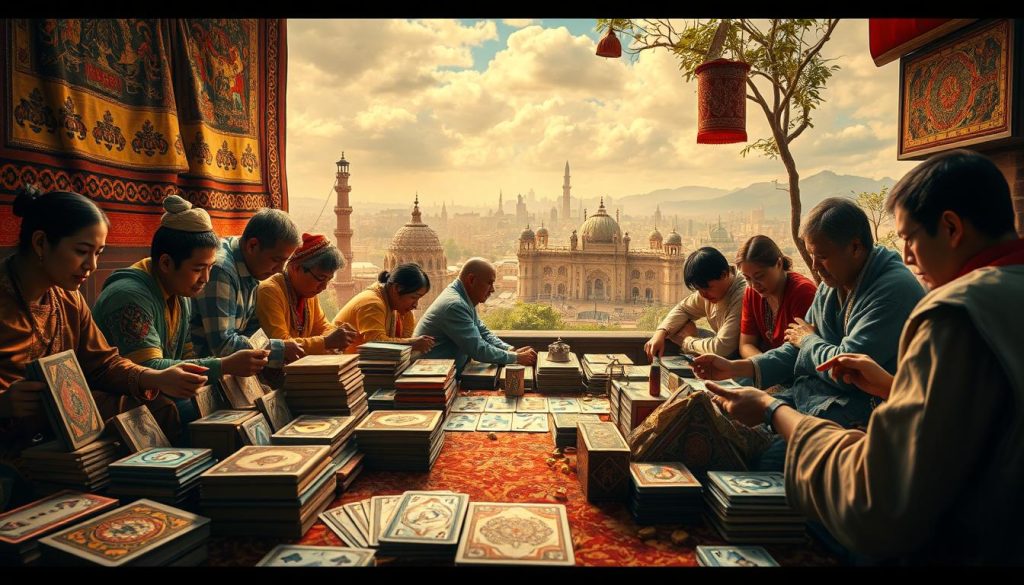Card games have been exciting players for many years. They create moments of fun, strategy, and connection. These games are more than just a hobby. They are a cultural treasure that connects people across ages.
Classic card games are loved at family game nights and social events. They offer a mix of skill, fun, and socializing that digital games can’t match. This makes them a favorite in the United States.
Whether you’re experienced or new, traditional card games are fun for everyone. They challenge your mind, start conversations, and make memories. Few activities can do this as well.
The reason these games are still popular is their simplicity and deep strategy. They also bring people together. Traditional card games are a beloved form of entertainment that keeps evolving but stays true to their core appeal.
The Rich History Behind Traditional Card Games
Card games have a long and exciting history. They have traveled across centuries and continents. Their journey shows how cultures mix and people get creative.
The first card games came from ancient China. They started in the Tang Dynasty, around the 9th century. These early cards were not like today’s decks. They were used for games and to predict the future.
Ancient Roots of Card Gaming
As card games spread, they changed a lot. They showed how people innovate and connect. Important moments in their history include:
- Chinese “money cards” used for gambling and trading
- Persian and Arabic changes to card game designs
- European improvements to card deck designs
- Introduction of the standard 52-card deck
From Royal Privilege to Popular Pastime
At first, card games were only for the rich. They were made by hand and showed off wealth. But soon, they became fun for everyone.
Now, card games bring people together. They connect people from all walks of life and ages.
Why Traditional Card Games Remain Popular Today
Card games still draw in players of all ages. They have a timeless charm that goes beyond new tech and changing trends. These games mix fun, skill, and social time, making them still loved today.
Several key factors keep traditional card games popular:
- Accessibility: You need little to play and can do it almost anywhere
- Social connectivity: They help people meet and talk face-to-face
- Cognitive challenge: They boost your brain with strategy and problem-solving
- Low-cost entertainment: You only need a basic deck of cards
Modern trends have made card games even more popular. Now, you can play classic games online through apps and websites. This has brought these games to a new, younger crowd while keeping their classic charm.
Card games appeal to people of all ages. They’re great for family nights and big tournaments. These games offer a mix of luck, skill, and social fun.
Essential Skills Developed Through Card Gaming
Card games are more than just fun. They help players grow by teaching important skills. These skills include strategic thinking and how to get along with others.

Playing card games boosts your brain power. You learn to think ahead and make smart choices quickly. This is key in card games.
Strategic Thinking and Decision Making
Card games teach more than just how to play. They help you:
- Think about what might happen next
- Solve problems fast
- Change your plan when needed
- Know when to take risks
Mathematical and Probability Skills
Card games also improve your math skills. You learn about chances and do quick math without thinking.
- Figure out the chances of certain cards
- Understand how likely things are to happen
- Do math in your head
- Spot patterns
Social Intelligence and Reading Opponents
Card games also teach you about people. You learn to notice and understand what others feel and think. This is very useful in life.
Playing card games can make your free time very useful. You learn skills that help you in many areas of life.
Most Beloved Traditional Card Games Worldwide
Card games have been loved by many for years. They bring people together, from family games to big tournaments. These games are fun and connect us in special ways.
Some card games are loved everywhere. They have unique rules and are enjoyed by many. Let’s look at some of these favorites:
- Poker: A game of skill and strategy from the United States
- Bridge: A game that needs deep communication and smart thinking
- Hearts: A game where players try to avoid certain cards
- Rummy: A game that tests your ability to find patterns
- Spades: A game that’s big in North America
Each game offers a special experience. Poker is all about reading others and managing risks. Bridge needs great communication between partners. Hearts is about avoiding certain cards.
Rummy is all about quick thinking and finding patterns. These games are more than just fun. They help us learn and connect with others.
These games are loved by many around the world. They are fun and help us meet new people. They also help us get better at thinking and working together.
The Social Dynamics of Card Playing
Card games connect people across ages and backgrounds. They offer fun ways to interact and build relationships.
Card games do more than entertain. They bring people together, improving communication and deepening friendships.
Building Family Bonds Through Games
Family game nights with card games make special memories. They offer many benefits:
- Encourages direct communication between family members
- Creates opportunities for intergenerational interaction
- Develops strategic thinking skills
- Builds trust and collaborative spirit
Card Games as Social Catalysts
In social settings, card games are great icebreakers. They help people feel at ease by offering fun, structured activities.
Community Building at Card Tables
Card game communities are lively places where people share and bond. Local clubs, online groups, and tournaments show how games unite different people.
Card games are great for connecting with family, friends, or even strangers. They help build strong social bonds and communities.
Basic Rules and Etiquette in Traditional Card Games

Learning card game rules and etiquette makes game nights fun. Knowing the basics helps everyone have a good time. It’s important whether you’re playing with family or friends.
Game night guidelines include some key rules for most card games:
- Respect fellow players and maintain a friendly environment
- Learn the specific rules of each card game before playing
- Handle cards carefully and avoid unnecessary distractions
- Practice fair play and good sportsmanship
Good card playing etiquette is more than just rules. It’s about making the game fun for everyone. Players should talk clearly, avoid fights, and keep things competitive but fair.
Important card game rules include knowing who goes first, when to shuffle, and how to score. Each game has its own special rules. Learning these ensures the game goes smoothly and everyone knows what to do.
Great game nights need respect, clear talk, and a focus on fun. By following these tips, players can make nights to remember, beyond just the cards.
How Technology is Preserving Classic Card Games
The digital world has changed how we play card games. Now, classic games are available online, reaching players everywhere. This lets people from different places play together, keeping old traditions alive in new ways.
Technology gives card game fans many ways to play:
- Virtual card rooms that feel like real games
- Mobile apps for playing on the go
- Learning sites for improving your skills
- Global multiplayer games
Digital Adaptations of Traditional Games
Today’s digital platforms turn old card games into fun online experiences. Creators make sure the games feel just right, keeping the strategy and social fun. They add things like tutorials and leaderboards to make the games better.
Online Communities and Virtual Card Rooms
Virtual card rooms are lively places for players to meet and play. They have tournaments, practice areas, and chat rooms. This lets players from all over the world compete and learn together.
Learning Platforms for Card Game Enthusiasts
Online, there are special sites for learning card games. They have tutorials, strategy guides, and interactive lessons. These tools help both new and experienced players get better at card games.
The Psychology Behind Card Game Appeal
Card games tap into deep psychological needs. They make us feel challenged, connected, and mentally sharp. This is why we find them so captivating.
Playing card games boosts our strategic thinking and skill. It’s a place where we can test our minds, make smart choices, and feel the rush of winning.
- Uncertainty creates excitement and emotional engagement
- Skill-based gameplay provides a sense of personal achievement
- Social interactions enhance the overall gaming experience
Gambling psychology adds to the appeal of card games. The mix of chance and strategy gives us a dopamine boost. This makes us want to play more.
People with different personalities like different card games. Some like games that need a lot of strategy. Others prefer games that are more about luck.
Knowing how card games work in our minds helps us see their value. They bring people together, across ages and cultures.
Card Games in Different Cultural Contexts
Card games are more than fun—they show us different cultures around the world. Each place adds its own twist to card games. This makes simple decks into powerful ways to connect people of all ages.

Different places have their own card game styles. These games show off their unique social ways and history. They often mean more than just fun.
Regional Variations in Card Playing
Card games vary all over the world:
- In Japan, Hanafuda cards show beautiful seasonal pictures
- Mexican Lotería uses pictures instead of numbers
- French tarot games mix games with mystic divination
Cultural Significance and Symbolism
Card games often mean more than just playing. They carry deep cultural stories and social traditions. In many places, playing cards during holidays brings families together. It keeps family stories alive.
Festival and Holiday Gaming Traditions
Many cultures play card games during celebrations. In Chinese New Year, families play games together. Native American communities use cards to share stories and teach lessons.
Learning about these card game traditions shows us the strong bonds formed through play. It connects people from different cultures in fun ways.
Competitive Scene in Traditional Card Games
The world of card game tournaments has changed. Now, traditional card playing is a high-stakes competition. Professional players compete in big events with thousands of participants and big prizes.
These competitions show the skill needed in card games. It’s more than just playing for fun.
Competitive gaming strategies have gotten more complex. Top players spend a lot of time:
- Analyzing game patterns
- Developing advanced psychological techniques
- Mastering probability calculations
- Understanding opponent behavior
Big tournaments like the World Series of Poker and international Bridge championships are popular worldwide. They draw players from all over, showing card games are loved globally.
Professional card players train hard, like athletes. They study game mechanics, practice mental strength, and find unique ways to read opponents. This has made card games a respected sport.
Digital platforms have opened up new chances for card game tournaments. Online competitions let players from all over the world show their skills. This has created new ways for aspiring pros to get noticed and compete globally.
Teaching Traditional Card Games to New Generations
Sharing card games is a special tradition that links families. It’s more than fun—it helps kids learn, bond, and grow their minds. Parents and teachers can make game time educational and fun.
Teaching games to kids needs smart plans that keep them interested and right for their age. Start easy and add more complexity as they get better and understand more.
Starting with Simple Card Games
Begin with simple games that have easy rules:
- Go Fish – Great for young kids
- Uno – Teaches color and number matching
- War – Introduces basic card value concepts
- Memory – Develops concentration skills
Progressive Learning Techniques
Learning card games should grow step by step. Break down hard rules into easy steps. Use pictures, show how to play, and ask questions.
Making Learning Fun and Engaging
Make learning card games exciting. Use positive words, fun challenges, and celebrate wins. This keeps kids excited to learn more.
The main aim is to teach and make memories, not just follow rules. It’s about starting a lifelong love for card games.
Modern Innovations in Traditional Card Games
Card game innovations are changing the world of traditional gaming. Designers are making classic games exciting again with new mechanics and fun elements. Brands like Bicycle and Cartamundi are working with game developers to create unique experiences.
New card games now have digital features. Some games have apps that track scores, offer tutorials, or add augmented reality. These updates make games more fun for younger players while keeping the social fun of traditional games.
Modern twists on old games are making card gaming more exciting. Independent designers are trying new themes, stories, and ways to play together. Games like Exploding Kittens and Cards Against Humanity show how new ideas can attract new players.
The future of card gaming is bright and full of possibilities. As tech gets better and designers get creative, card games will become more interactive and fun. These changes will keep card games popular across generations, offering fun and connection.

